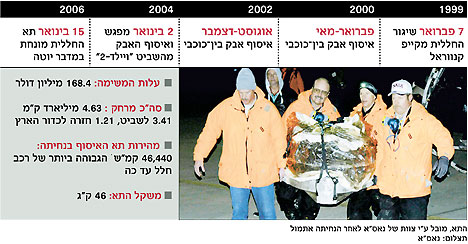
A spacecraft chamber containing dust samples from the comet "Wild-2" was dropped yesterday at noon Israel time at an isolated landing site in the Utah desert, to the applause and cheers of proud scientists and researchers. According to scientists, at least a million samples of the comet and interstellar dust are in the container.
The landing was the highlight of the seven-year journey of the NASA Stardust spacecraft, which passed by the comet in 2004, collected dust particles and collected them in a chamber that was parachuted to Earth. "This is a great end to the operation," said Carlton Allen of NASA's Johnson Space Center. Since comets are icy bodies composed of ice and dust that are about 4.6 billion years old (the time of the formation of the solar system), the researchers hope that the dust will provide initial information about the origin of our planetary system. The dust grains contain many of the organic molecules necessary for life, and some of the particles are considered more "mature" than the sun itself.
A rescue helicopter team went to the landing site to pick up the cabin and transport it to a nearby base. From there, the cell will be flown to the Johnson Space Center in Boston, where scientists will open the container containing the cosmic dust. After being separated from the packaging material which consists of 99.8% air, the dust particles will be examined and examined under a microscope.
"Stardust" was launched in 1999, and has since traveled a distance of about 4.6 billion km. In 2004, the spacecraft passed through the halo of gas and dust surrounding the comet, and managed to collect the samples that were packed and waiting to be parachuted back to Earth. For the purpose of collection, the spacecraft activated a "glove" the size of a tennis racket, which transferred the particles to an aluminum container.
On its way, the spacecraft also collected cosmic dust - tiny particles floating in the solar system - which, according to the hypothesis, originate from stars that exploded and "died". In addition, the spacecraft transmitted 72 black-and-white photographs showing the surface of the comet "Wild-2", which is approximately 805 million km from Earth.
The cosmic dust will keep researchers busy for years. Their plan is to slice the samples, most of which are thinner than a human hair, and examine the tiny pieces under a microscope to learn about their chemical structure and the process that shaped the universe.
The space probe entered the Earth's atmosphere at a record speed of 46,440 km3. The cabin's first parachute opened at an altitude of about 168.4 km, and immediately after that another, larger parachute opened, which navigated and gently landed the cabin. The cost of the mission was estimated at 128.4 million dollars (without the launch vehicle), of which 40 million dollars for the development of the spacecraft and XNUMX million dollars for the operation and execution of the mission.
The success of "Stardust" stands in contrast to the failure of the "Genesis" mission that sent dust created by solar storms to Earth. In 2004, Genesis crashed on landing, its collection tank ruptured, and the solar atoms inside were contaminated.
https://www.hayadan.org.il/BuildaGate4/general2/data_card.php?Cat=~~~377483686~~~18&SiteName=hayadan
